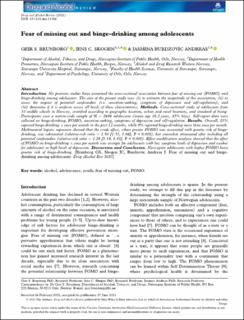| dc.contributor.author | Brunborg, Geir Scott | |
| dc.contributor.author | Skogen, Jens C. | |
| dc.contributor.author | Burdzovic Andreas, Jasmina | |
| dc.date.accessioned | 2021-11-08T13:57:37Z | |
| dc.date.available | 2021-11-08T13:57:37Z | |
| dc.date.created | 2021-08-16T09:56:19Z | |
| dc.date.issued | 2021-07 | |
| dc.identifier.citation | Brunborg, G.S., Skogen, J.C., Burdzovic Andreas, J. (2021) Fear of missing out and binge-drinking among adolescents. Drug and Alcohol Review. | en_US |
| dc.identifier.issn | 0959-5236 | |
| dc.identifier.uri | https://hdl.handle.net/11250/2828419 | |
| dc.description.abstract | Introduction
No previous studies have examined the cross-sectional association between fear of missing out (FOMO) and binge-drinking among adolescents. The aim of the present study was: (i) to estimate the magnitude of this association; (ii) to assess the impact of potential confounders (i.e. sensation-seeking, symptoms of depression and self-regulation); and (iii) determine if it is uniform across all levels of these characteristics.
Methods
Cross-sectional study of adolescents from 33 middle schools in Norway, stratified according to geographic location, urban and rural locations, and standard of living. Participants were a nation-wide sample of N = 2646 adolescents (mean age 16.2 years, 43% boys). Self-report data were collected on binge-drinking, FOMO, sensation-seeking, symptoms of depression and self-regulation.
Results
Overall, 21% reported binge-drinking ≤ once per month in the past 12 months, while 9% reported binge-drinking more than once per month. Multinomial logistic regression showed that the crude effect, where greater FOMO was associated with greater risk of binge-drinking, was substantial (relative-risk ratio = 1.50 [1.35, 1.66], P < 0.001), but somewhat attenuated after including all potential confounders (relative-risk ratio = 1.28 [1.14, 1.43], P < 0.001). Effect modification analyses showed that the effect of FOMO on binge-drinking ≤ once per month was stronger for adolescents with low symptom levels of depression and weaker for adolescents at high levels of depression.
Discussion and Conclusion
Norwegian adolescents with higher FOMO have greater risk of binge-drinking. | en_US |
| dc.language.iso | eng | en_US |
| dc.publisher | John Wiley & Sons Ltd. | en_US |
| dc.rights | Attribution-NonCommercial-NoDerivatives 4.0 Internasjonal | * |
| dc.rights.uri | http://creativecommons.org/licenses/by-nc-nd/4.0/deed.no | * |
| dc.subject | alkohol | en_US |
| dc.subject | binge-drinking | en_US |
| dc.subject | FoMo | en_US |
| dc.title | Fear of missing out and binge-drinking among adolescents | en_US |
| dc.type | Peer reviewed | en_US |
| dc.type | Journal article | en_US |
| dc.description.version | publishedVersion | en_US |
| dc.rights.holder | © 2021 The Author(s) | en_US |
| dc.subject.nsi | VDP::Medisinske Fag: 700::Helsefag: 800 | en_US |
| dc.source.pagenumber | 1-8 | en_US |
| dc.source.journal | Drug and Alcohol Review | en_US |
| dc.identifier.doi | 10.1111/dar.13356 | |
| dc.identifier.cristin | 1926188 | |
| cristin.ispublished | true | |
| cristin.fulltext | original | |
| cristin.qualitycode | 1 | |

